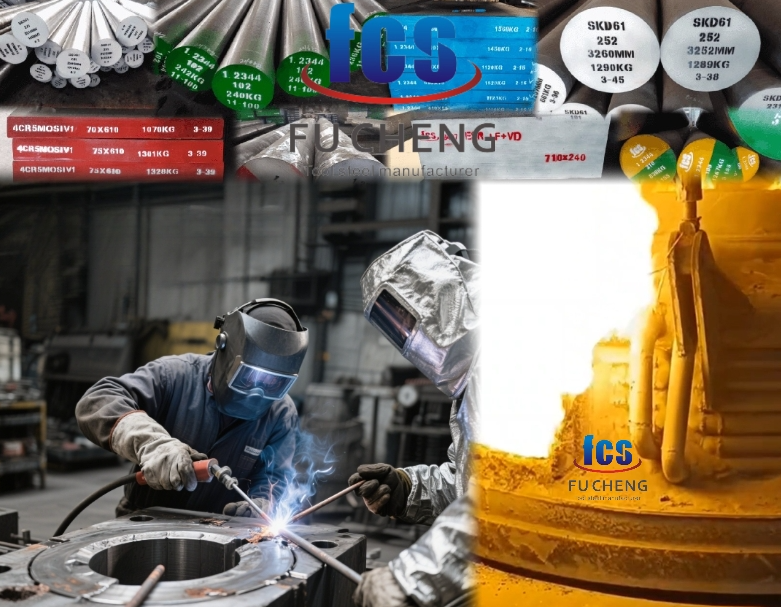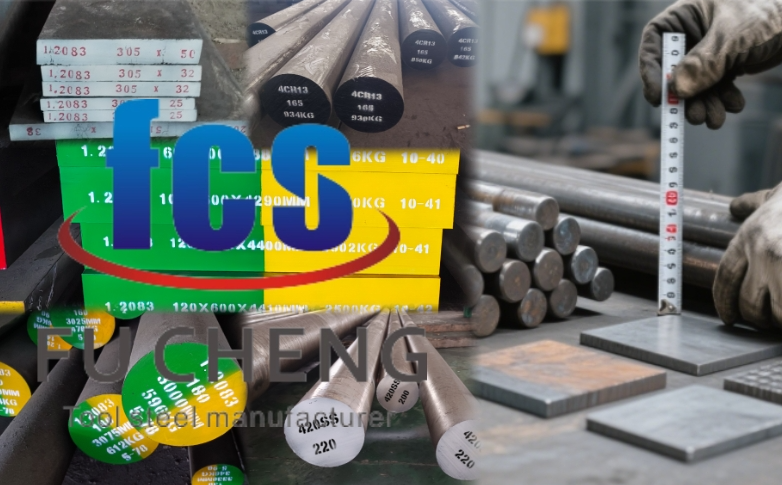Have you ever looked at a pile of welding rods? I find it can be confusing to determine which rod is the best choice. This is especially true for those challenging hot work steels. I’ve noticed it’s easy to feel a bit lost. Some rods, in my experience, spark a lot, almost like fireworks. Others glide smoothly. I think picking the right rod truly impacts your project’s outcome. It can be the difference between success and failure. But, I’ve observed many people overlook one key detail during their weld material selection…
Expert Opinion:
“When you weld special steels used for hot work tools, I find that many people often miss an essential point. This is controlling the heat properly, both before you start welding and while you’re in the middle of welding passes. In my metallurgical engineering career, which has spanned over 25 years, I’ve seen so many welds crack or fail. I firmly believe most of these issues could have been prevented. The key would have been managing the heat correctly. You see, these hot work tool steels have a good amount of carbon and other special metals mixed in. This composition makes them prone to cracking if they experience a sudden, rapid change in temperature. I refer to this as thermal shock. Based on my experience, I always suggest following these key steps for better thermal management. First, you should always preheat the steel to a minimum of 315°C (600°F). Second, I stress that it’s critical to maintain this temperature consistently throughout the entire welding job. What you do after welding is just as critical. I recommend a specific heat treatment after welding. This involves cooling the steel down slowly. Then, a proper tempering process is essential. In my view, doing this helps to reduce the internal stresses that build up in the metal. It also ensures the metal develops the best possible internal structure. From my professional viewpoint, creating a strong, successful weld is about far more than just choosing the correct welding rod. It’s truly about the entire cycle of heating and cooling that your steel goes through.”
———— Dr. Thomas Miller , Metallurgical Engineer with 25+ years specializing in tool steel applications, Fellow of the American Welding Society
Welding Hot Work Tool Steels: Processes and Rods

My Recommended Rod Types for Hot Work Tool Steels
For joining hot work tool steels, I generally rely on two types of welding fillers. Based on my experience, stick electrodes are one option. These create many sparks as I work. TIG rods are my other preferred choice. I find they flow smoothly, like liquid metal, along the seam. To me, choosing between them is like deciding whether to use a bold paintbrush or a delicate pen. I feel these fillers allow me to express my creativity in my fabrication projects. Each type leaves its own distinct mark on the hot, molten metal.
Stick Electrodes: You’ll see these welding rods marked with “E” for Electrode. This mark tells you they carry current. For hot work tool steels, I suggest considering examples like.
| Type | Examples |
|---|---|
| Stick Electrodes | Impax Weld QRO 90 Weld Calmax/Carmo Weld 1253 – H13 Hot Work Tool Steel Electrode (Tungsten free) |
TIG Rods: If you’re using TIG welding processes, here are some rod options I find work well.
| Type | Examples |
|---|---|
| TIG Rods | Impax TIG-Weld QRO 90 TIG-Weld Dievar TIG-Weld Calmax/Carmo TIG-Weld Product code 6111, developed for H13 steel |
Examples of Welding Rods for Hot Work Tool Steels

If you’re choosing welding rods for hot work steels, I recommend matching the filler material to your specific alloy and how you’ll use it. In my experience, some welding rods are specially made for high heat and tough conditions. They resist wear well and perform reliably. Let me show you some examples.
Common Welding Rods I’ve Seen for Hot Work Tool Steels
Eureka 72
I find this rod works well for welding H12 steel alloys. It provides great hot hardness and resists wear very well. This makes it a good choice, in my opinion, if the welded joint will face high heat and constant rubbing. From what I’ve seen, Eureka 72 also resists impacts fairly well. Its as-welded hardness is 50–55 HRC.
Eureka 31
I suggest using Eureka 31 for H13 steel alloys. This rod is very tough. It stays hard even at high temperatures and consistently resists rubbing and impacts. Its as-welded hardness is between 49–54 HRC. I think it’s a strong option for parts that need to be durable and resist heat.
WT H-13
I’ve seen this welding rod used a lot for joining hot work tool steels, especially when you need good resistance to heat checking and strong properties when the steel is hot. WT H13 resists wear well. I often see people choose it for die repair, welding screws, pneumatic hammers, and punches. You can get it in several forms, like electrode, flux cored wire, MIG, and TIG rods.
Forms of Hot Work Tool Steel Welding Rods I Know
From my experience, you can find hot work tool steel welding materials in several forms. This allows you to pick what best fits your welding process and what you prefer:Stick Electrode,Solid MIG Wire,TIG Rods,Metal Cored Wire,Flux Cored Wire,Micro TIG Rods.I believe these choices help welders and fabricators pick the perfect welding rod. You can choose based on what your project needs, the equipment you have, and the particular steel alloy you are working with. This flexibility is really useful, in my view, for getting the best results.
Selection Considerations for Hot Work Tool Steel Welding Rods

Picking the correct welding rod for hot work tool steel is very important. It impacts weld quality, its lifespan, and the tool’s overall performance. Based on my experience, here are key factors and tips I find helpful:
Composition Matching Is Essential
I always stress that you must match the welding rod’s composition to the base hot work tool steel. When you use a filler with a similar chemical makeup, the welded joint will react to heat treatment just like the original steel. This way, you avoid spots with different hardness levels. Those spots can lead to tool failures later on. For example, H12 TIG rods are made just for H-series steels. They create chromium-tungsten-molybdenum (CrWMo) welds that you can still heat-treat.
Look for Compatible Rods Matched to Your Alloy
Some welding rods are made to work directly with certain tool steel grades. This is true if you’re welding on material that is annealed or already hardened. I recommend looking for these. Take Uddeholm’s consumables, for instance. They are made to match the base steel. I find this kind of compatibility very important for good performance and for later steps like heat treating.
Insist on High Quality and Tight Analysis Control
I believe rod quality directly affects how consistent and good your weld will be. I suggest picking consumables made with strict chemical analysis control. This way, you get steady hardness and a predictable heat-treatment result every time. This is very important when you plan to polish or photo-etch the welded parts of mould components.
Evaluate Rod Composition and Hardness
In my experience, hot work tool steel rods often have a mix of elements. These include chromium, molybdenum, vanadium, and tungsten. I’ve found these mixes make the steel harder, more resistant to wear, and last longer. As an example, Tool Steel Hardfacing TIG Rods HF6 can give you about 60 HRC hardness. This makes them a good choice, in my opinion, for surfaces that face a lot of friction and high heat.
Match Rods to Welding Application
If you ask me, when you repair high-speed steel tools or die steel, or if you’re hard-facing carbon steel to resist wear, you should look for rods made for these specific jobs. I’ve seen that special rods for repair and bringing tools back to use can fix machining mistakes and make tools last longer.
Typical Welding Rod Product Listings for Hot Work Tool Steels
For hot work tool steel applications, I suggest you choose welding rods that match the specific tool steel grade. These products should also deliver the needed performance for high heat and wear conditions. Here are some popular and trusted welding rods for hot work tool steels. I’ll list their main features and applications.
Comprehensive List of Hot Work Tool Steel Welding Rods
| Product Name | Compatible Tool Steel | Process | Hardness (HRC) | Main Use/Remarks |
|---|---|---|---|---|
| Eureka 72 | H12 | Stick/TIG | 50–55 | Offers excellent hot hardness and wear resistance; suited for demanding repairs and high-temperature applications. |
| Eureka 31 | H13 | Stick/TIG | 49–54 | Features high-temperature toughness and abrasion resistance; reliable for H13 tool repairs and maintenance. |
| Eureka 88 | H19 | Stick/TIG | 55–60 | Recommended for hardfacing, overlays, and applications requiring high-heat endurance and superior wear protection. |
| Eureka 74 | S7 | Stick/TIG | 55–60 (as welded) | Used for cutting and shearing parts; provides shock resistance and high toughness at room temperature. |
| 1253 H13 Electrode | H13 | Stick | 54–57 (as welded) | Suitable for tool and die repair; notable heat-checking resistance with balanced chemistry (0.35% C, 1.35% Mo, 0.97% V, 5.26% Cr). |
| 6111 H13 TIG Rod | H13 | TIG | Similar to 1253 | TIG version of 1253 electrode; supports precision welding on H13 tool steels. |
| Sifsteel HF6 | Die/Tool/High-Speed | TIG | ~60 | Known for excellent crack resistance and high hardness (4% Cr, 8% Mo, 2% V, 1.5% W); used for repairing dies, tools, and wire guides with extreme wear. |
| WEARtig Tool 55, 58 | Hot/Cold Work | TIG | 53–58 | Preferred for high-hardness repairs on both hot and cold work tool steels. |
| QRO 90, ORVAR 2 M | Hot Work | TIG/MIG | 48–53 | Popular for forging die and hot work tool repairs; balances toughness and wear resistance. |
| DIEVAR, HOTVAR, ALVAR 14 | Hot Work | TIG/MIG | 48–53 | Suited for complex or heavily loaded dies, offering high toughness and wear resistance in demanding applications. |
summary
My experience with hot work steel welding rods has taught me something crucial. Your success depends on picking the right rod. I find that the best rod choice goes beyond just the technical details on a spec sheet. You must understand your specific project requirements. Knowing your work environment is also key. Whether you opt for stick electrodes or TIG rods, I recommend one thing. Always match the rod’s composition to your base material. This approach makes a huge impact. I want to share what I’ve learned. I hope it helps you approach your welding projects with greater assurance. Based on my work with hot work tool steels, selecting your rod with care will give you top-quality results.

